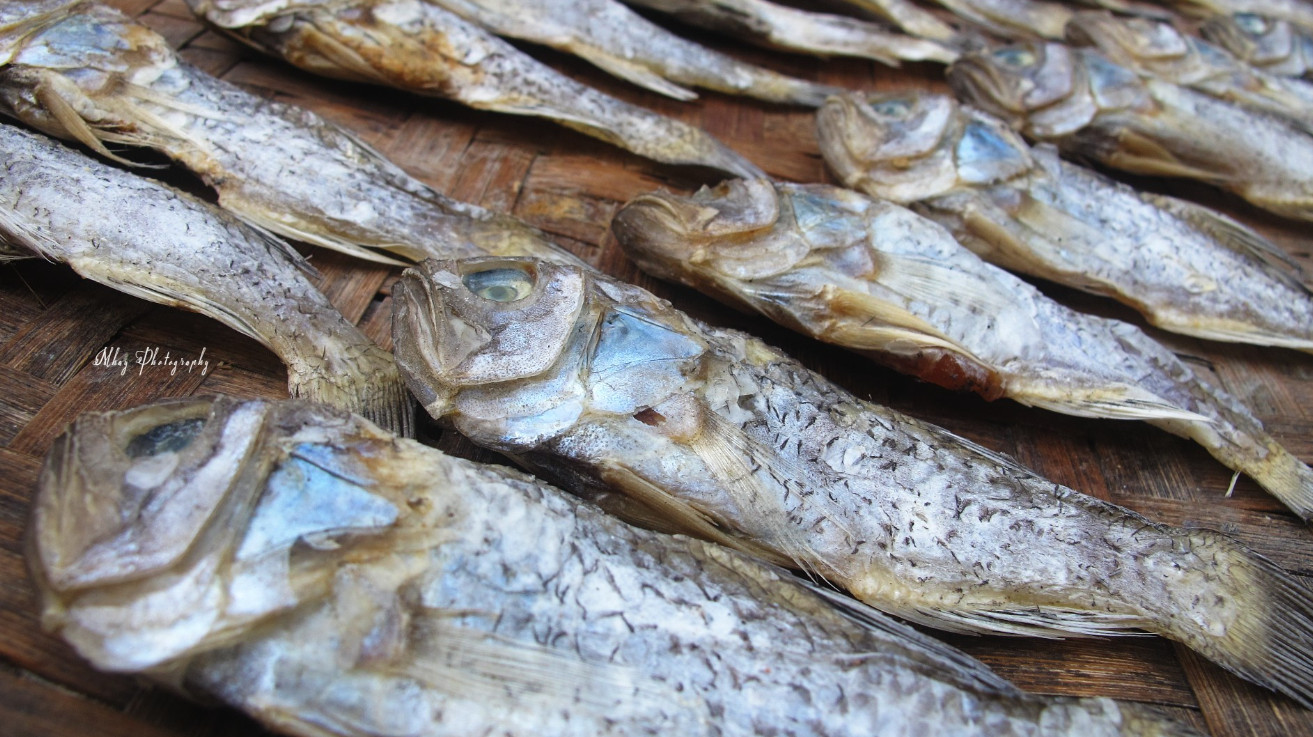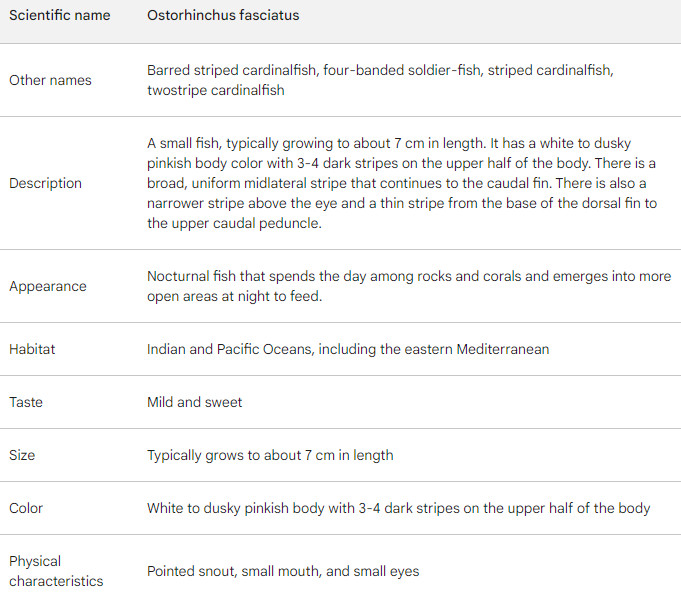Moong fish (Hiligaynon/Ilonggo), the broad-banded cardinalfish, is a marine fish native to the Indian and Pacific Oceans. It is a Lessepsian migrant to the eastern Mediterranean through the Suez Canal from the Red Sea. It has several vernacular names, including barred striped cardinalfish, four-banded soldier-fish, striped cardinalfish, two stripe cardinalfish, and Bungka in Tagalog.

The scientific name Ostorhinchus fasciatus comes from the Greek words “ostros,” meaning “pointed,” and “rhynchos,” meaning “beak.” The fish’s scientific name refers to its pointed snout, while its other names refer to its striped appearance.
Moong Fish Characteristics
The broad-banded cardinalfish is a small fish, typically growing to about 7 cm long. It has a white to dusky pinkish body color with 3-4 dark stripes on the upper half of the body. A broad, uniform mid-lateral stripe continues to the caudal fin. There is also a narrower stripe above the eye and a thin stripe from the base of the dorsal fin to the upper caudal peduncle.
The broad-banded cardinalfish is a nocturnal fish that spends the day among rocks and corals and emerges into more open areas at night to feed on zooplankton. It is a paternal mouthbrooder: the male incubates the eggs in his mouth.
The taste of the broad-banded cardinalfish is mild and sweet. It is a popular fish in some parts of the world, but it is not a major commercial species.
Here is a table summarizing the scientific name, other names, description, appearance, habitat, taste, size, color, and physical characteristics of Moong Fish

Health Benefits of Moong
While moong is not a well-known species in terms of its potential health benefits, I can provide some general information about the health benefits associated with consuming Moong.
Fish, in general, can be a good source of essential nutrients and offer several potential health benefits:
- Omega-3 Fatty Acids: Many fish are rich in omega-3 fatty acids, particularly EPA (eicosapentaenoic acid) and DHA (docosahexaenoic acid). These fatty acids are known for their potential cardiovascular benefits, including reducing the risk of heart disease, lowering triglyceride levels, and supporting overall heart health.
- Protein: Fish is a high-quality source of protein that provides all essential amino acids necessary for various bodily functions. Adequate protein intake is vital for muscle growth, repair, and overall body function.
- Vitamins and Minerals: Fish can be a good source of vitamins and minerals such as vitamin D, B12, iodine, selenium, and zinc. Vitamin D is vital for bone health, immune function, and various metabolic processes.
- Brain Health: The omega-3 fatty acids found in fish, especially DHA, are associated with cognitive health. DHA is a major component of brain tissue and may contribute to brain development and function, potentially reducing the risk of cognitive decline.
- Eye Health: Some fish, such as salmon, are rich in nutrients like astaxanthin and omega-3s that are beneficial for eye health. Omega-3s may help prevent age-related macular degeneration and dry eye syndrome.
- Inflammation Reduction: Fish’s omega-3 fatty acids have anti-inflammatory properties, which may help reduce chronic inflammation in the body. Chronic inflammation is associated with various health issues, including heart disease and certain autoimmune conditions.
- Skin Health: Omega-3 fatty acids can contribute to healthy skin by maintaining moisture and reducing inflammation. Some skin conditions, like eczema, may benefit from increased omega-3 intake.
It’s important to note that the health benefits of consuming Moong fish can vary based on the type of fish, its diet, preparation methods, and individual health conditions.
How to Prepare and Cook Moong Fish
- Fresh Fillets:
- If you have fresh Moong fillets, you can prepare them by cleaning and deboning the fish, if necessary.
- You can marinate the fillets with herbs, spices, and some oil for flavor. Lemon juice, garlic, and fresh herbs like parsley or dill work well.
- Grilling, baking, or pan-frying are popular cooking methods for fish fillets. Coat the fillets with oil to prevent sticking, and cook until the flesh is opaque and flakes easily with a fork.
- Dried:
- Drying fish is a preservation method that can be used for various fish species.
- Clean and gut the fish, then remove the head and tail. Slice the fish open along the belly to aid in the drying process.
- Salt the fish to help draw out moisture. You can also season the fish with spices if desired.
- Hang the fish in a well-ventilated area or use a food dehydrator to dry them until they are completely dry and have a leathery texture.
- Dried fish can be used in stews and soups or rehydrated and incorporated into various dishes.
- Canned or Bottled:
- Canning or bottling fish involves cooking and sealing it in a container to preserve it.
- Clean and cook the fish before placing it in cans or bottles. You can add seasonings, herbs, and a bit of liquid (such as oil or broth) for flavor.
- Seal the cans or bottles tightly and follow proper canning procedures to ensure safety.
- Canned or bottled fish can be used in salads, sandwiches, or as a protein source in various dishes.
- Fermented:
- Fermenting fish is a traditional preservation method in some cultures.
- Clean the fish and coat them with salt or a mixture of salt and spices.
- Place the fish in a container and allow them to ferment for a specific period, which can vary depending on the recipe.
- Fermented fish can have a strong flavor and aroma. They are often used in small quantities to add flavor to dishes.
Bottom Line
Moong fish is not widely recognized as a common food fish, and specific culinary information about preparing and cooking it may be limited. However, when preparing and cooking fish in general, there are several methods you can consider, such as fresh filleting, drying, canning or bottling, and even fermentation.
Remember that the choice of cooking method depends on your preferences, the texture of the fish, and the culinary traditions of your region. Suppose you intend to cook Moong fish or any other less common fish species. In that case, it’s a good idea to research local recipes, consult with experienced cooks, or seek guidance from culinary experts to ensure safe and enjoyable preparation.
See Also:
- Tabilos Fish: Pope’s Ponyfish Description and Characteristics
- Dapa Fish: 10 Health Benefits of Flatfish, Description, and Side Effects
- Banak: 10 Health Benefits of Mullet Fish Description and Side Effects
- 9 Health Benefits of Ackee Fruit, Description, and Side Effects
- 7 Health Benefits of Akebi Fruit, Description, and Side Effects
